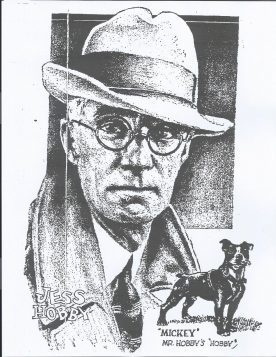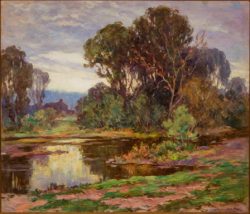Arthur Pointer, Jess Hobby, drawing published in Oak Leaves, Dec. 7, 1933.

Jess Hobby 1871–1938
As a boy, Jesse Carl Hobby studied painting with Elbridge Grafton and H. B. Hewley in his native Cooperstown, New York. He later moved west to work under Mart S. Hazelton, in Omaha, Nebraska, learning the craft of scenic design. Until at least 1924, when he visited Madison, Wisconsin, with the La Vern Stock Company, Hobby traveled around the Midwest with touring theater companies. Based in Joliet, Illinois, in 1900, he later moved to nearby Morris and then to Chicago. Hobby undertook decorative painting projects in addition to theater work, including backdrops for displays at Chicago’s 1933 Century of Progress Exposition. He was a member of the United Scenic Artists Association, a national labor union and professional organization.
Around 1921, Hobby with his wife and family took up residence in suburban Oak Park, Illinois, where he painted a curtain for the Warrington Theatre (formerly the Warrington Opera House). Independent of such large-scale work, Hobby had long pursued landscape painting. In Oak Park, he studied with Munich-trained painter Alfred Juergens, one of several local resident artists. Hobby painted throughout the Chicago region, notably at Starved Rock, around the DuPage and Rock rivers, near Joliet, and in southern Wisconsin. His portrayals of familiar spots in Oak Park and vicinity were occasionally reproduced in local newspapers, and he was a familiar and beloved figure in the village.
In the 1930s, while continuing to work as a decorative painter, Hobby gained a modest local reputation for his landscapes. His solo exhibition at Oak Park’s Blackstone Art Galleries in 1932 caught the attention of several Chicago newspapers. That year, the Chicago Tribune’s Eleanor Jewett praised Hobby’s Art Institute in Winter in the annual exhibition of the All-Illinois Society of the Fine Arts. In 1935, Hobby won the Society’s first gold medal. He also exhibited in the members’ group shows of the Austin, Oak Park, and River Forest Art League (now the Oak Park Art League) and in 1935 a display of his landscapes took place in the Drake Hotel on Michigan Avenue in Chicago. Beginning in 1932, Hobby teamed with his friend and fellow Oak Park painter John Nolf to give art classes in his studio. Hobby was visiting Nolf’s apartment when he died suddenly of a heart attack at the age of sixty-eight.
Wendy Greenhouse, PhD
